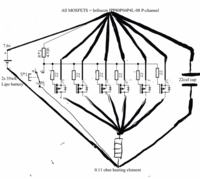first_time_mike
Newbie level 4

Hi there. I intend to use a 7.8v 46wh lipo battery to power a 0.12ohm heating element, I can only use p channel mosfets as the switch because of a digital read out I plan to add will act to complete an N channel circuit. I've been given a circuit to work to but to be honest I know very little about electronics. To my eyes this seems overly complicated.
Can anyone tell me if this will even work, and at that would it be efficient?
Please excuse the rough diagram, I found drawing this on a mobile phone to be quite difficult!
Any help here would be genuinely appreciated.
Mike

Can anyone tell me if this will even work, and at that would it be efficient?
Please excuse the rough diagram, I found drawing this on a mobile phone to be quite difficult!
Any help here would be genuinely appreciated.
Mike

Last edited by a moderator:

